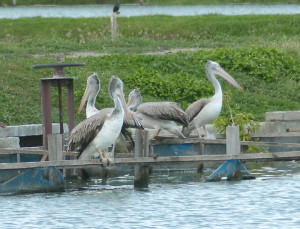
The wetlands of Petchaburi include freshwater rice fields and fish ponds, salt farms and mudflats all of which attract huge numbers of migratory birds in the months October to April. With large numbers of birds, including the critically endangered Spoon-billed Sandpiper, come large numbers of bird watchers but very few people visit the area in the wet season. Certainly in the months of May to August the large congregations of shorebirds are absent but the region still has some species of interest which make the area worth a visit at any time of the year as I was able to show some visitors recently.
Spending a day in the Petchaburi wetlands we were able to make some interesting observations, including some resident species in breeding plumage as well as good numbers of large waterbirds and a few rare species.
I have written a number of times about enjoying watching the weavers in the Petchaburi rice fields but they are worth mentioning again as it is a really nice experience to see all three species that occur in Thailand in full breeding plumage and actively building their distinctive nests; seeing these colourful birds at this time of year is a real highlight. Javan Pond Heron is another species which makes a remarkable change from non-breeding to breeding plumage becoming a really beautiful bird and male Watercock is a superb bird which we were able to see recently calling from a rice field and a species which can usually be observed at its best at this time of year.
Even in the salt pans, which is where all the waders can be seen in “winter”, we were able to see good numbers of Spot-billed Pelicans, Painted Storks and a single Milky Stork; all of which regularly occur at this location during the wet season in recent years. Another interesting sighting was a Pacific Reef Egret in the King’s Project area – a species I have only ever previously seen on the coast – we also saw more Spot-billed Pelicans here.
On our recent trip we also visited the beach at Laem Pak Bia which leads up to the sand spit where Malaysian Plovers breed and we were able to find some over-summering shorebirds – 3 Sanderling and 2 Black-tailed Godwits as well as a Bridled Tern feeding offshore with a flock of Little Terns. Two years ago at the same time of year I saw a flock of Caspian Terns here which goes to show that some interesting observations can be made even in this season.


 July 3rd, 2015
July 3rd, 2015  Nick
Nick  Posted in
Posted in  Tags:
Tags: 









